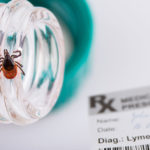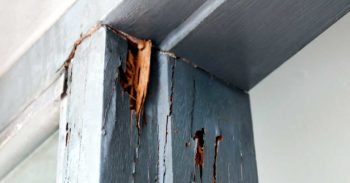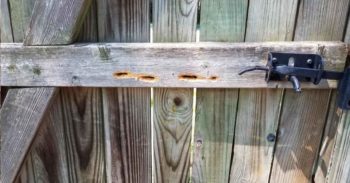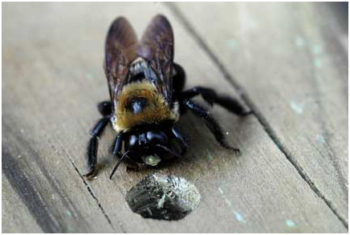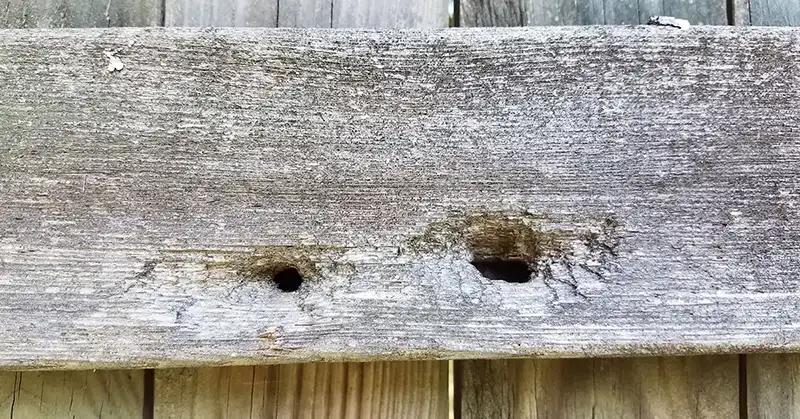
Among the pests that emerge in the spring are carpenter bees. Knowing how to distinguish them from honeybees, wasps and yellow jackets is important, especially since carpenter bees can damage your home.
How to Recognize Carpenter Bees
While both carpenter bees and bumblebees are black and yellow, they have distinct differences. Bumblebees are fuzzy all over. Carpenter bees have a large, shiny black abdomen. Male carpenter bees have a whitish spot on their faces and can look scary. Their territorial tendencies make them likely to dive bomb people who get too close to their nests, which makes them seem predatory, but they actually don’t have stingers. According to TodaysHomeowners.com, female carpenter bees do have stingers but rarely sting unless you provoke them.
Sometimes you notice the effects of carpenter bees before you notice the insects themselves. Carpenter bees chew perfectly round holes about a half an inch in diameter in wood to create nests.
Will Carpenter Bees Damage My Home?
Carpenter bees make holes in wood because they like to nest in soft, unpainted wood and lay their eggs there. That means they are often attracted to window trim, porch ceilings, eaves, fascia boards, and siding, especially when made of wood like pine, cedar, cypress, and redwood. Other targets can be fence posts, swing sets, decks, and outdoor furniture – unless they’re made of treated lumber or hardwood, neither of which carpenter bees like.
Other signs of carpenter bee infestations are:
- Scraping sounds from inside the wood holes
- Sawdust outside the hole
- Fan-shaped stains outside the holes (they defecate before entering their nest)
Typically, carpenter bees chew into wood for about an inch before the tunnel turns and follows the wood grain. Tunnels can branch off so that multiple bees can live in the offshoots. While carpenter bees aren’t as systemically destructive as termites and carpenter ants are, they can damage a home. If the nest is recent and the number of bees is small, damage is less.
Nests involving lots of carpenter bees or many successive generations of carpenter bees can cause a great deal of damage. The increasing tunnels can compromise the structure of the wood. If water gets into those tunnels, it will speed up the wood rotting. As bad as that is, it’s worse if it happens within wood siding that protects the building’s structure. Carpenter bees can even attract woodpeckers, which can hear bees nesting and its larvae. The woodpeckers then cause more damage while trying to get at the tasty larvae.
Can Carpenter Bees Kill a Tree?
Carpenter bees were making nests in trees long before they started burrowing into houses. As with the damage they can cause to homes, enough bees over time can kill a tree. Hardwood trees like oak, walnut, and maple are generally safe since carpenter bees prefer softwood like pine, cedar, and cypress.
How to Prevent Structural Damage From Carpenter Bees
As with any infestation, the faster you address it, the less damage carpenter bees can cause. It’s also essential that you get all the carpenter bees because any missed will just continue to cause damage. Arrow Exterminating identifies the type of insect and provides the correct treatment to ensure successful removal.
After the carpenter bees are eradicated, fill the holes left behind so no water can enter and cause rot. To avoid future problems, treat all wood since carpenter bees prefer untreated wood. Some experts recommend paint over stain, claiming that carpenter bees don’t realize something is wood if they can’t detect wood grain.
Let Arrow Handle Your Carpenter Bees
If you think you have a carpenter bee, wasp, or yellow jacket problem, call Arrow Exterminating to identify and eliminate them. Arrow will help you identify if you have a problem, explain our plan to eradicate your infestation, and give you the peace of mind you need. To get started, contact Arrow Exterminating today.

